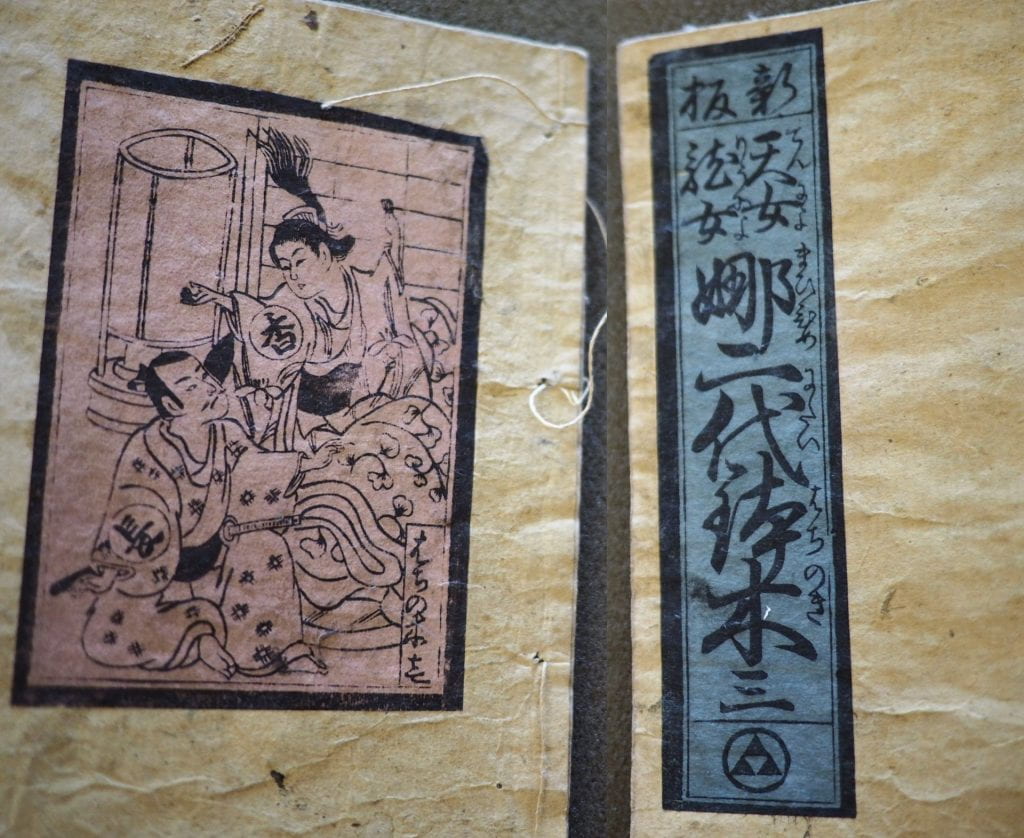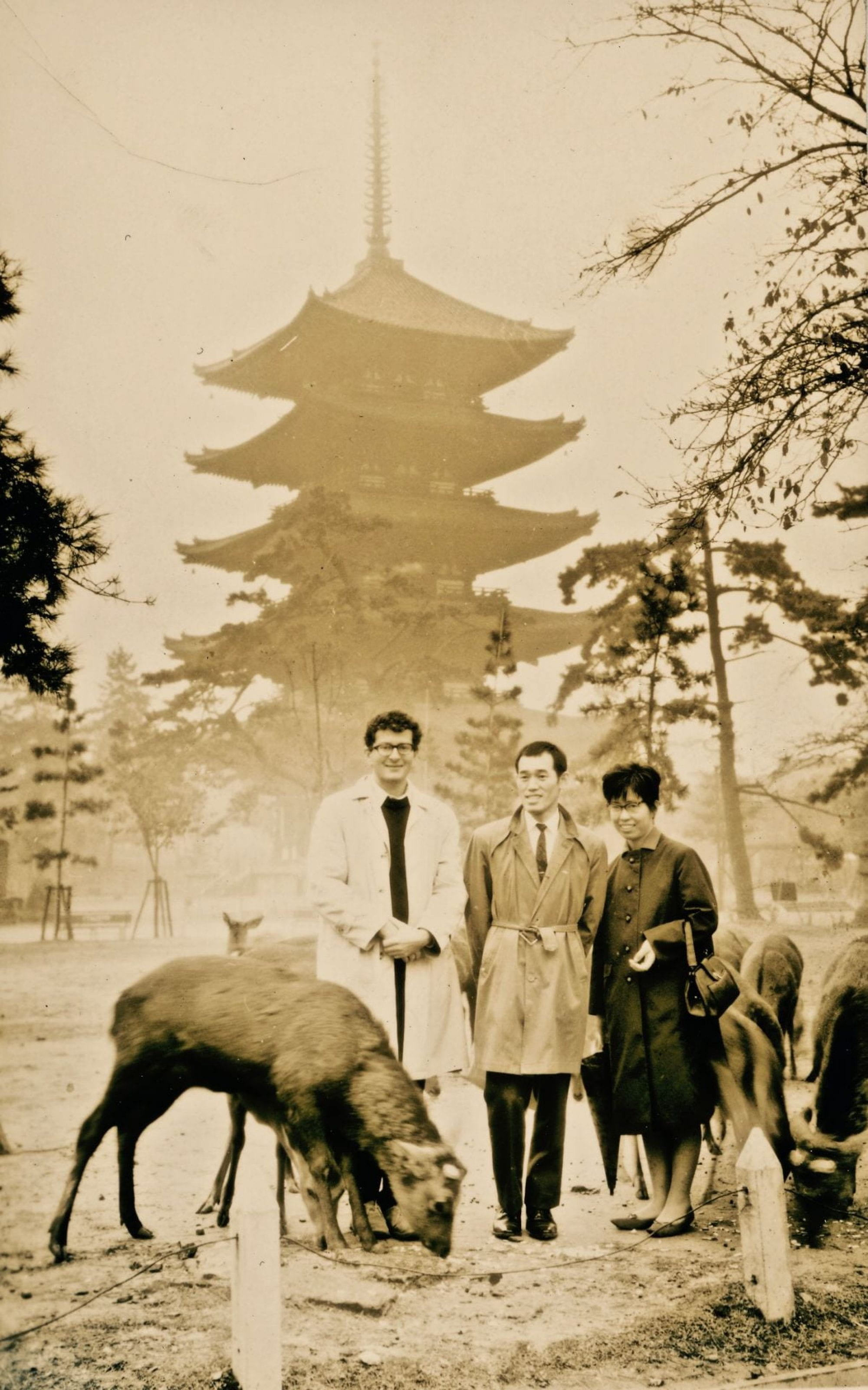

Artist: Torii Kiyomitsu I (Japanese, 1735-1785)
Title: Maihime nidai hachinoki (Second Generation Hachinoki)
Date: 1774
Publisher: Urokogataya Magobei
Descripton: woodblock printed book, black ink; paper covers; pouch binding; 18.3 cm tall; 13 cm wide; includes fascicle 1 + bound fascicles 3–5 (each fascicle is 10 pages + cover)
Category: pictorial fiction, aohon (blue blook)
Location: Kislak Center for Special Collections, Arthur Tress Collection, Box 29, Item 17.
Gift of Arthur Tress
Maihime nidai hachinoki (Second Generation Hachinoki) is a derivation of Hachi no ki (The Potted Trees), a 14th c. story also adapted for Noh and Kabuki theater. Kiyomitsu’s rendering of the story follows the supernatural travails of the adult children of samurai Tsuneyo.
To spare expense, kusa-zoshi (smaller pictorial books) were printed in black ink only, and often later hand-colored by the owner of the book. Serial stories were sold in separate installments or in volumes of 2-3 fascicles. The lower cost of production enabled a wider audience to buy books, rather than borrow.[1]
Publisher Urokogataya’s mark of triangles (pulled from his seal) appears on the title strip of bound fascicles 3-5, as well as on the first page of each fascicle. Fascicles 1, 4, and 5 have cover plate illustrations that are more crudely drawn copies of interior illustrations. The physical characteristics of the book, publication date, as well as sophisticated content, place it in the later aohon (blue book) category of kusa-zoshi, [2] though the recycled paper cover has faded from blue to tan.
Throughout the book are pictorial references to the original story, such as Tsuneyo’s armor; a framed painting of the traveling monk; a scene of the siblings at home with the three potted trees in the foreground; and kimono decorated with plum, cherry, and pine blossoms.[3]
Artist Torii Kiyomitsu I was the third leader of the Torii School for painting and printing, based in Edo. While the school remained rooted in theatrical publications, Kiyomitsu expanded the Torii style with multiple color woodblock printing and with a lighter, graceful style in his own work. Though he is best known for his actor and beauty prints,[4] he and other leading print artists also illustrated these early comic books related to the stage.[5]
Other copies can be found in the National Diet Library Digital Collections, and Harvard Yenching Library.
Selected reading:
Kimbrough, R. Keller. “Illustrating the Classics: The Otogizōshi Lazy Tarō in Edo Pictorial Fiction.” Japanese Language and Literature, vol. 42, no. 1, 2008.
Robert J. Baran, “Hachi-No-Ki, A Perspective,” ABS Bonsai Journal, Vol. 26, Summer 1992.
Lane, Richard Douglas. Images From the Floating World: The Japanese Print. New York: Dorset, 1982.
Kern, Adam L. “Kabuki Plays on Page—and Comicbook Pictures on Stage—in Edo-Period Japan.” Publishing the Stage, edited by Keller Kimbrough & Satoko Shimazaki.
[1] Kimbrough, R. Keller. “Illustrating the Classics: The Otogizōshi Lazy Tarō in Edo Pictorial Fiction.” Japanese Language and Literature, vol. 42, no. 1, 2008, pp. 257–304. JSTOR, www.jstor.org/stable/30198062.
[2] Ibid., 257.
[3] Baran, Robert J. “Hachi-No-Ki, A Perspective,” ABS Bonsai Journal, Vol. 26, Summer 1992, pp. 3-4, 23. The potted trees are Ume (Plum), Sakura (Cherry), and Matsu (Pine).
[4] Lane, Richard Douglas. Images From the Floating World: The Japanese Print. New York: Dorset, 1982, p. 89.
[5] Kern, Adam L. “Kabuki Plays on Page—and Comicbook Pictures on Stage—in Edo-Period Japan.” Publishing the Stage, edited by Keller Kimbrough & Satoko Shimazaki. Center of Asian Studies, 2011, pp. 168, 172.
Posted by Catherine Gontarek
October 8, 2019
